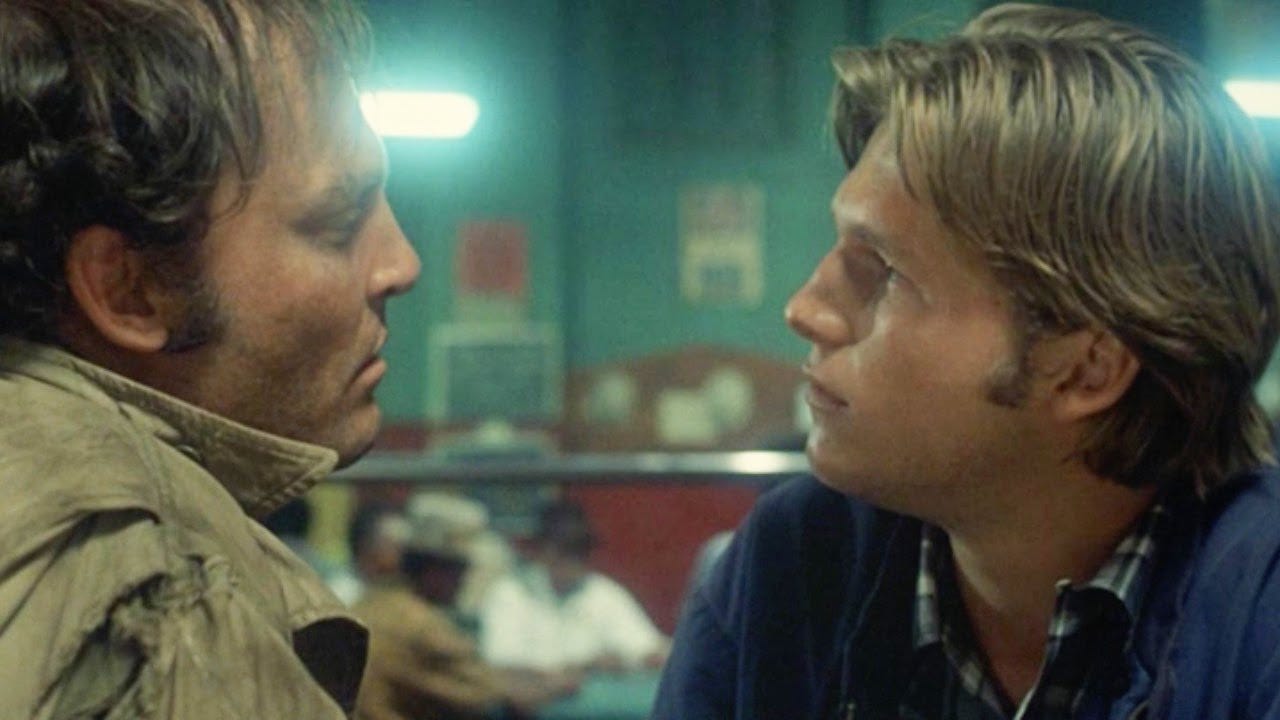Help Me Make it Through the Night: Fat City's Poetic Loneliness
John Huston’s late career was just another anomaly in a career filled with them. By 1972, many of the lauded Hollywood filmmakers of the 40s and 50s were either retired, had passed away, or were making films entirely out-of-sync with the burgeoning “new” Hollywood. Not John Huston. Huston was always a maverick against the powers that be. In 1952, Lillian Ross published Picture– an examination of the difficulties and tribulations in Huston’s adaptation of Stephen Crane’s The Red Badge of Courage (1951), mainly covering his quarrels with the studio system and the butchered state of the film upon release. Naturally, he was troubled— a notorious drinker (allegedly culpable for two drunk driving deaths) and a distant father.
Even if Andrew Sarris referred to his works as “more than the sum of his parts,” Huston was always willing to take a chance on less than commercially viable texts for adaptation. He was unafraid to bring the words of Carson McCullers, Arthur Miller, Herman Melville, or Tennessee Williams to the screen. His later career, although containing the one-for-them Annie (1982), was composed of numerous literary adaptations. To name a few: Flannery O’Connor’s Wise Blood (1979), Malcolm Lowry’s Under the Volcano (1983), and Rudyard Kipling’s The Man Who Would Be King (1975). None are arguably as essential as his adaptation of Leonard Gardner’s boxing novel Fat City (1972).
Gardner’s 1969 novel is an understated masterpiece. Drawing from his experience as a middleweight boxer, it tracks a short period of two amateur fighters in Stockton– the baby-faced high school graduate Eddie Munger and the over-the-hill “old thirty” of Billy Tully. The narrative tracks both characters on different parts of their path in life. Munger– unsure of where to go after high school– is introduced to this subculture in its alluring yet brutal form. Billy Tully’s life is less than stable. His window for success has closed. He is on the verge of thirty and constantly flipping between retired/active in the ring, all while dealing with brutal sharecropping conditions to pay for rent and his boozing habits.
Even in the milieu of Kerouac, Bukowski, Ken Kesey, or Don Carpenter, Gardner’s novel stands as an essential piece of down-and-dirty realism. It’s a novel that captures a specific time and place but is also about characters stuck there. There’s no overarching moral endpoint but an intense humanity and immediacy. Billy and Eddie hardly learn much by the novel’s end. Billy is left single after a breakup with his fiery girlfriend and fellow boozer Oma. Meanwhile, Eddie is unceremoniously brought back to Stockton following some uncomfortable hitchhiking after a match in Salt Lake City, left to wonder more about his future and boxing ceiling. Upon looking up any review of Fat City, either the novel or the film, each mentions the title’s meaning, it would be remiss to engage with the film as a text without it. When Gardner sat down with Time magazine to promote Fat City in 1969, he said that the title came from a piece of slang for the “good life” he saw written on the wall of a Black tenement building in a photo once. Gardner thinks that “fat city”, or a good life, is not just a mirage in the desert for Eddie and Billy but something “no one is ever going to reach.”
Given trends, it would not be shocking if Huston, in his mid-60s, would fail to capture an uncompromising contemporary novel. The contemporaries of his Hollywood did not have their finger remotely on their pulse (take, for example, a “serious” director like Otto Preminger directing cult-camp like Skidoo). However, stylistically, Fat City feels something only partially downstream from a Cassavetes picture, Bob Rafelson’s Five Easy Pieces, or Barbara Loden’s Wanda. (J Hoberman said it is “obvious now as the rejuvenated director’s contribution to the New Wave zeitgeist”). Huston’s oeuvre almost exclusively covers losers and the pathetic. None of them, however, seem as pitiable or brimming with the pathos of Stacey Keach’s hardened Billy Tully, Jeff Bridges’ amiable but naïve Eddie Munger, or Susan Tyrell’s impulsive Oma.
Gardner adapted the screenplay of his novel– and it shows. Besides a different (but thematically similar) ending and less emphasis on Munger’s life and the hardened boxing manager Ruben, it is a faithful adaptation in both tone and events. Fat City puts to image the neon-lit dive bars and streets of Stockton, the small to medium-sized arenas, bottle-laden motel rooms, the central Californian crop fields, and the boxing gyms in all their less-than-glory.
Plenty of boxing features would follow Fat City, but its melancholy allows it to stand up to time. Instead of the feel-good underdog triumph of Rocky or the searing masculine propulsion of Raging Bull, Fat City is much more low-stakes but much more tenderly human. It is the type of film that burrows itself into your soul. It’s another essential piece of the long and complicated legacy of John Huston.
Throughout the film, a leitmotif is outlaw country legend (and occasional New Hollywood actor) Kris Kristofferson’s beautiful “Help Me Make it Through the Night'', if a movie like this is to have a song ascribed to it– then it is this. It plays one final time in the film’s final moments when Billy approaches Eddie outside a restaurant late at night. As the two sit, Billy, in an act of overwhelming, dissociative loneliness, asks Eddie to keep him company. The two sit silently, sipping coffee, as the credits roll. In these lines, Mr. Kristofferson better sums Fat City’s ethos than me:
“Yesterday is dead and gone
And tomorrow's out of sight
And it's sad to be alone
Help me make it through the night
And it's sad to be alone
Help me make it through the night
I don't want to be alone
Help me make it through the night”

